Rube Goldberg was best known for his popular cartoons depicting complicated gadgets performing simple tasks in indirect, convoluted ways. The cartoons led to the expression "Rube Goldberg Machines" to describe similar gadgets and processes. (Wikipedia)
Today many of the energy systems proposed for our “transition” are akin to the Rube Goldberg machine. Take for example multiple wind turbines spread over vast distances, all networked together by an array of cabling, with brake systems and gearboxes to help extend the narrow bandwidth of wind conditions they are able to operate in. They are then coupled to switchgear and a transmission network that has to be designed to handle their full generation capacity despite the fact that they typically only generating about 30-35% of their installed capacity. Because the wind often doesn’t blow some back up capacity also has to be added to the mix, usually gas turbines. Things get really funky when pumped hydro schemes or giant gravity battery cranes to lift huge blocks for storing electricity as kinetic energy are added. Everything that is added represents the cost to shore up intermittent power and adds complexity.
European wind output August to now from ~ 255GW of installed capacity.
It even kind of looks a lot like a Rube Goldberg cartoon…
Enter the undefeated champion of the energy system reality checks, Thermodynamics.
It often amazes me how reluctant the renewable energy advocates are to address the question of system thermodynamics.
For those unfamiliar with the term, you will perhaps be surprised to learn that you actually know much more about it than you realize.
You will recall from school that energy can not be created or destroyed it simply converted to other forms. This is the first law of thermodynamics. In the lab you would have pushed a trolley along the desk and observed that the chemical energy from your muscles was initially converted to motion (kinetic energy) as the trolley moves forward then to friction (heat) and noise until the trolley comes to rest.
The second law of thermodynamics deals with entropy which, in a very loose definition, is that disorder in a system increases until everything in the system reaches the same temperature. What this means in practical terms is that the number of energy conversions increases over time to the point where the original energy input is completely dissipated, and the entire system comes to rest. We typically understand this as losses in an energy system. A high entropy system is one with a lot of conversions and a low entropy system has the least number of conversions. If two trolleys were pushed with the same amount of force, the high entropy trolley will come to rest very quickly and a low entropy trolley will travel much further before it stops.
As you can see above there are a lot of conversions and much disorder in the Rube Goldberg wind generation system. The intermittent output is by definition disordered and the number of conversions required to attempt to deal with this intermittency makes this a very high entropy system.
What this means is that of the 30-35% of their installed capacity that these turbines generate much less than that will eventually be available at the wall sockets of the houses around the country. The price at the wall socket has to account for all this infrastructure and the associated loses, making it very expensive power.
I guess this is why we never talk about thermodynamics….








